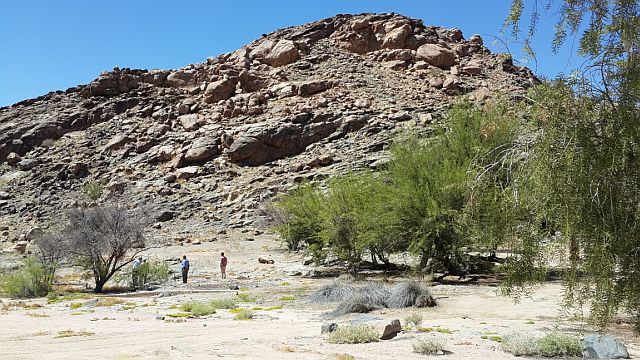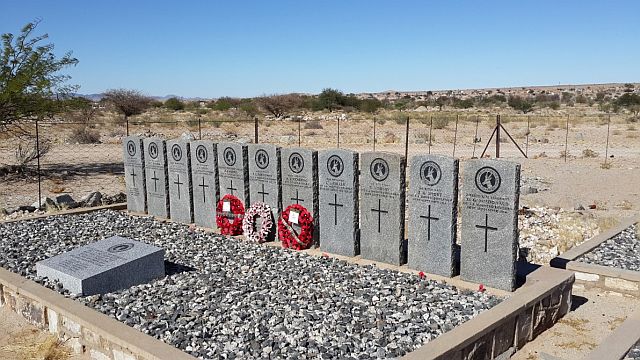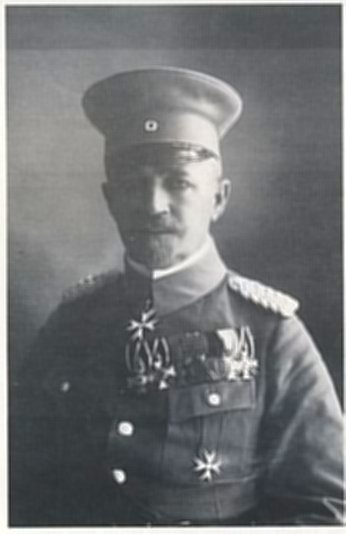

 The South African
The South African
Maj Gen Andersen (Honorary Colonel and previous Officer Commanding THA) and Lt Col Ron Ludeman (Rtd), accompanied by a small team of Gunners and MOTHs and General Andersen's son, were determined to obtain a better understanding of this battle by visiting the site. They swiftly reached the conclusion that altliough the battle could be described as a disaster trom the South African point of view, the courage of the participants could not be questioned.
An Artillery Perspective of the Battle
Neil Orpen, in The History of the Transvaal Horse Artillery 1904-1974 (THA Regimental Council, 1975), draws heavily on the report of Lt (subsequently Brig) FB Adler MC, VD* when describing the events at Sandfontein. After describing the journey from Johannesburg to the SWA border via Cape Town and Port Nolloth, Orpen continues his account, which is reproduced here, courtesy of the Transvaal Horse Artillery:
* MC = Military Cross
VD = Volunteer Officer's Decoration
'On 11 September, patrols were sent out to the Orange River, and the next day Gen Lukin was authorised to enter German territory. The 4th and 5th SAMR under Lt-Cols Dawson and Berrange set off to occupy Raman's Drift on the way to Warmbad in German South-West Africa, and Houm's Drift. They were to secure the high ground north of the Orange River at both places. There was some skirmishing, a few casualties were suffered and some prisoners taken, and small enemy forces withdrew towards a group of three wells at Sandfontein, about 18 miles [26 km] from Raman's Drift.
Part of Lukin's force on 19 September occupied Sandfontein with a view to ultimately advancing on the line Raman's Drift-Warmbad-Kalkfontein-Seeheim. Taking into account the existing availability of transport and water, the force commander decided that the greatest strength he could maintain on the river line was the 600 rifles he already had at Raman's Drift, Houm's Drift and Sandfontein, plus another 300 rifles and one battery of artillery.
With the 4th Permanent Bty's teams on loan to double-span the transport across the Koa Valley Desert, the THA set off from Steinkopf without any escort. They watered at Een Riet and then, with no further chance of getting water till they reached the river, they set off on a march of nearly 50 miles [80 km].
After some 30 hours without being able to replenish their water supply, the battery reached Raman's Drift at 11 o'clock that night and were able to quench their thirst in the Orange River.
Sandtontein
Appreciating that the Germans intended to attack Sandfontein, Gen Lukin ordered Lt-Col Grant to reinforce Welby's squadron and, in view of the urgency of the matter, a column set off at 5:30 pm, leaving behind a troop with wagons to follow with supplies. The Right Section of the THA under Lt F B Adler, with its two 13 pdrs, accompanied the three troops of SAMR and a machine-gun section, but all reserve ammunition was left on the supply wagons, as no further transport could be obtained for the 24-mile journey. Marching through the night, with only one short halt after midnight, Grant's column was within sight of the isolated conical koppie at Sandfontein by first light on 26 September.

At the foot of the koppie to the west was a pump near the well, a stone kraal and a couple of detached buildings and sheds, but Welby had no time to do more than construct schanzes by way of fortification, and his predecessors had not entrenched the position or built any sort of protection for guns. By the time Grant's column sighted Sandfontein, Welby had already had reports about enemy movements from his own patrols, and he had spoken on the telephone to Gen Lukin at Raman's Drift and learned of Grant's approach with reinforcements.
Any support which Gen Lukin may have hoped for from the North-West Cape had evaporated since Lt-Col S F Maritz, with 1 000 riflemen and three machine guns at Upington and Kakamas, refused to divide his force and had already decided to resign rather than enter South-West Africa. In fact, he went into rebellion with 700 of his men.
With Maritz's treachery having removed any threat to their rear on the south-east, the Germans could concentrate nearly the whole of their active force of about 2 000 rifles and three batteries of artillery at Warmbad. On the night of 26 September, while Grant was moving north with only some 122 fighting men to reinforce Welby's 120, the enemy marched rapidly south by two roads. By dawn they had seized the defile on the way to Houm's Drift, and another detachment was moving to cut the two roads from Sandfontein to Raman's Drift as the sun rose on 26 September.
Unaware of the trap into which he was riding, Lt-Col Grant, at 7:25 am that day, reached the wells and heard the latest reports from Capt Welby. The two were still talking and Grant's column had not even dismounted when a message came in from the top of the koppie to say that a column was advancing from the direction of Warmbad - the north-east - with SAMR patrols retiring before it. At the same time, a telephonist ran up to say the line to Raman's Drift had been cut.
Climbing the koppie at once to get a view of the ground, Grant had barely reached the top when he saw two more enemy columns coming in from the east and the west at a gallop to occupy the ridges and outcrops on those sides. Within minutes a fourth column on the south-west, near the Raman's Drift road, completed the envelopment of the SAMR and THA by a greatly superior force.
Grant hurriedly distributed his riflemen so as to get the best field of fire, sited his two machine-guns on the southern spur of the koppie and took up position himself on top of the koppie. As soon as the enemy appeared on the Raman's Drift Road and while the gunners were awaiting their turn to water, Adler unlimbered the THA 13-pdrs, one between the kraal and the main well and the other between the well and the koppie, with the mule teams grouped against the wall of the kraal.
Within half an hour of arriving at the wells, the guns were in action and about to face a gruelling baptism of fire. At about 8:00 am, Adler was ordered to engage the southern enemy column, and the two 13pdrs opened fire on German forces advancing from the south-west at about 4 000 yds' range [about 3650m] on the very road Grant's column had just used.

"The simultaneous discharge of the two quickfirers," said an eye-witness report, "echoed again and again among the surrounding hills, followed a few moments later by the fainter sound of the exploding shrapnel."
The first rounds fell about 600 yds [about 550 metres] short, but the THA rapidly found the range, and soon the white smoke of exploding shells was mingling with the dust raised by the advancing enemy horsemen, who swung sharply to the right to gain the shelter of some low hills south of Sandfontein.
About ten rounds had been fired by the Transvaalers when from the northeast a battery offour guns on the nek of the ridge opened up and a beautifully timed shrapnel shell burst over the building in rear of the THA guns. A driver and a mule fell to the ground, and as the animals were moved to the other end of the kraal both THA guns swung round to meet this new threat, as time and percussion-fuzed shells began falling in and around the kraal and the guns.
Only the dust and smoke of the enemy guns could be seen and Adler, who had had his OP on a low ridge overlooking his own guns, was now forced to a spot nearer the kraal and the northern slopes of the koppie. One of the THA guns temporarily jammed, but Adler's first round at the enemy battery burst exactly over the ridge concealing the German guns, which were ranging on the summit of the koppie, where they obviously thought that the South African OP to be. By the accuracy of their fire the THA silenced the German battery for a while, but at 8:30 a.m., after half an hour's fighting, a second enemy battery came into action on the north-west at about 3 000 yds [2 740 metres]. One gun was turned on the new target and Adler immediately engaged. A direct hit forced the German guns to retire behind the crest, from which position they then shelled the THA, while the battery on the north-east again opened up on the 13-pdrs.
An infantry attack was developing, and now the two THA guns were almost trail-to-trail and firing at right angles to one another against a full battery each. Adler continued to engage the enemy to the north-west, BSM A R Harris was now firing on the Germans' guns to the north-east, whilst lines of enemy skirmishers advanced on the SAMR position. Taking advantage of cover provided by the dongas and rocky outcrops, the Germans soon ringed Grant's small force with riflemen and machineguns, which swept the South Africans with heavy fire from all sides.
Casualties Mount Up
The enemy battery to the north-west, using direct fire, took some time to get on target again, but when its fall of shot became more accurate, the one THA gun was completely blanketed by shells as the cones of fire of the two German batteries were superimposed. One of Adler's guns was firing over the kraal wall, which offered some protection from enfilade fire, but the gun shields proved of small value, and casualties began to mount up. SAMC orderlies gave what help they could under cover of the wall, but when shelling from the northwest again struck the gun crews, Adler managed to move to a position at the foot of the koppie, though several drivers and animals were hit.
The koppie itself was raked with shot and shell, one of the SAMR wrote, and the horses on picket lines near the foot of the hill were frantic with fear as shells burst around them. "The poor, helpless creatures stood in rows having their guts blown out, and it looked as if their riders would soon be treated in like manner", he stated.
The enemy infantry seemed to be held in check, but their gunners now had the range accurately and a deluge of shells rained on the THA. Every man on the guns was wounded and, at 10:30 am, a direct hit killed BSM Harris and knocked out his gun. The other gun still kept firing, and in a short time spare numbers brought Harris' gun into action again, but ammunition was now almost expended and there was great difficulty in getting forward what rounds there were in the wagons.
Describing the scene, P J Young of the SAMR stated, "The German shots were a thick rain on the hill, while their field guns struck at the two guns of the THA, around which figures were lying still. Towards 9:00 am (his times are wrong) after about three hours fighting, pressure got stronger. The young artillerymen's courage was grand. They worked with a will till they could do no more."
At about 11:00 am, more German artillery was spotted to the southwest and another two guns opened fire from the foot of the hills south of Sandfontein. All alternative positions round the koppie were under fire with shrapnel of high explosive, and after keeping up the hopelessly unequal contest for another 10-15 minutes, with further casualties and with ammunition practically exhausted, Adler - with Grant's permission pulled the guns back behind a low wall which offered some protection against rifle fire. The two 13-pdrs had been in action for over three hours in the open, and enemy machine-gun fire from the Raman's Drift road now made further service of them impossible. Even the position of the medical orderlies had been rendered untenable.
When the order to abandon guns was given, Bdr P M B Dunbarremained behind as the others scattered under terrific artillery and machine-gun fire. Gnr N C S McMaster - who was to become adjutant of the 7th Field Regiment in [the Second World War) - saw him grab a pickaxe to smash the buffer of his gun before seeking cover. Working under fire, Adler further disabled the guns by removing the breech blocks, and the unwounded gunners armed themselves with rifles and, from whatever cover they could find, they helped the infantry to keep the enemy at bay. Welby later paid tribute to the young gunners. "I must pay these gunners the compliment of expressing my admiration at their behaviour under fire," he said, "for it must be remembered that most of them were boys hardly out of their teens, who had never seen an angry shot fired before, and they behaved like veterans."
With the defenders' guns no longer in action, the enemy artillery concentrated on the horses and mules, turning the ground where they had been left into a shambles. Col Grant was wounded by machine-gun fire at midday, and Capt Welby took command shortly before a lull which lasted during the lunch hour. At about 2:00 pm, the German bombardment began again, continuing all afternoon and covering infantry attacks which were repulsed. Some 2 000 to 3 000 shells were pumped into the South African position during the day and, by 5:00 pm, the enemy were within 300 yds [274 metres] and the situation became critical. Half an hour later the Germans brought two mountain guns to within 1 200 yds [1 096 metres] of the Sandfontein koppie before opening a terrific bombardment with all available artillery.

Grant had resumed command by the time that high explosive turned the summit of the koppie into a veritable volcano and his staffs were wounded. The position was obviously irretrievably hopeless, and shortly before 6:00 pm, after holding out against overwhelming odds for 10 hours, Col Grant raised the white flag of surrender. His force had suffered 67 casualties - 22 per cent of its strength. Sixteen had been killed in action or died of wounds, and the German force of ten guns, four machine-guns and 1 500 riflemen had had 60 casualties. Their Commander, Col von Heydebreck, congratulated Grant on his excellent stand.
Except for a couple of members who escaped in the general confusion, the whole of Grant's force was captured. Among the gunners, RSM A E Harris, Bdr N J Pickering, [and] Drivers Cross, Marteens, July and Nfana were killed. A/Bdr F A Key and Cpl Alec Sondana died of wounds.
Altogether 45 of the THA were taken prisoner, and besides the two guns, they lost four ammunition wagons, a water cart and 33 horses and 53 mules killed or captured.
Col von Heydebreck - who lost his life in an experimental bomb explosion later during the campaign - showed the prisoners every consideration possible under the circumstances, which was in contrast to treatment they would later experience. The dead were buried in a little cemetery a short way behind the hill at Sandfontein and included the German Second-in-Command, Maj von Rapport, and his Adjutant.
Lt Adler and his men were marched off the night of their capture, with horses provided for the officers during a painful trek which ended at dawn at the Aluresfontein waterhole. They then continued to Warmbad, halting at noon at Skunbergs Queue. Officers and men were separated that night, and the following day the officers were sent on horseback to Kalkfontein, when Col van Heydebreck congratulated them on their fight and promised them good treatment, which he was powerless to ensure once they passed out of his hands.'
Maj Gen Andersen and Lt Col Ludeman (Rtd) could not help but be emotionally moved when walking and climbing over the battlefield one hundred years to the day after the Battle of Sandfontein. At Warmbad, they found the graves of BSM A E Harris, Bdr N J Pickering and A/Bdr F A Key in immaculate condition.
Return to Journal Index OR Society's Home page
South African Military History Society / scribe@samilitaryhistory.org